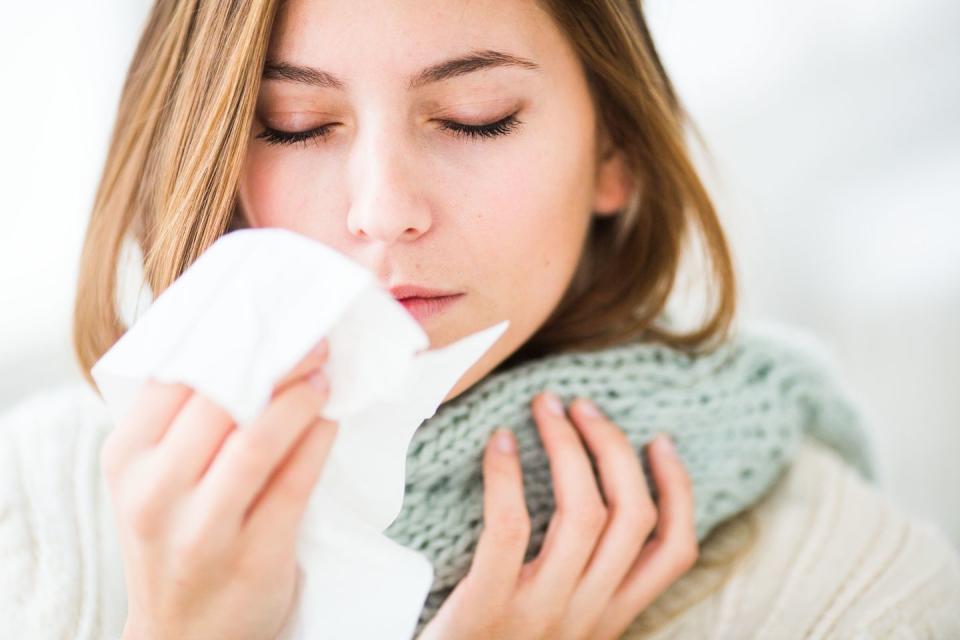How to Tell If Your Case of Cold, Flu, or COVID-19 Has Progressed to Pneumonia
This article was medically reviewed by Raj Dasgupta, M.D., an assistant professor of clinical medicine at the Keck School of Medicine of USC and a member of the Prevention Medical Review Board, on December 15, 2020.
Before COVID-19, we heard blissfully little about pneumonia—maybe you knew of an elderly relative who caught it while in the hospital, or someone told you after they were all better that their cold had actually been a case of “walking pneumonia,” meaning their symptoms were mild enough that they didn’t even know they had it and were out and about.
Well, pneumonia is currently having a moment, because it can be a dangerous complication of the novel coronavirus. Roughly 20% of COVID patients go on to develop COVID-19 pneumonia, although that number may be low, says pulmonary and critical care physician Raj Dasgupta, M.D., an associate professor of medicine at the University of Southern California.
That’s because if you’re having only minor symptoms, you probably won’t go to the hospital for imaging and a formal diagnosis, which is a good thing right now, given the COVID-related risks and how taxed healthcare workers are right now. “There’s no benefit of being at the ICU with a mild case,” says Dr. Dasgupta, as knowing for sure you have a mild case probably wouldn’t change your doc’s advice. “Either way, you’d be advised to stay at home, take it easy, sleep on your stomach and stay hydrated.”
A more serious case of pneumonia is another thing entirely. In normal times, pneumonia is the most common cause of hospital admission (aside from childbirth) for adults in the U.S. In fact, about 1 million adults are hospitalized for the condition per year, according to the American Thoracic Society.
But how can you tell the difference between pneumonia and the virus that may be causing it—say, the flu, COVID-19, or a really nasty cold? Here’s everything you need to know about spotting pneumonia, treating it, and avoiding it altogether.
What is pneumonia, exactly?
“Pneumonia is an infection in the gas-exchanging units of the lung (called the alveoli),” says Michael Niederman, M.D., clinical director of pulmonary and critical care medicine at Weill Cornell Medical College in New York. Translation: the air sacs in your lungs become inflamed or even fill with fluid or pus, which interferes with your body’s ability to deliver oxygen to your blood.

“About half the time, it’s due to bacteria,” says Dr. Edelman. “The other half the time, it’s due to viruses.” The most common type of pneumonia is caused by the bacteria streptococcus pneumoniae, in the same family of bacteria that causes strep throat. Influenza is also a key virus that can spur pneumonia, and fungi can be a culprit, too. The novel coronavirus, of course, can also cause pneumonia, albeit one with a longer incubation period than, say, the flu, says Dr. Dasgupta.
“Pneumonia develops if the organism overwhelms the patient’s host defenses,” says Dr. Niederman. This basically means that a foreign bug takes over your immune system, even if you’re generally healthy. That’s because certain organisms, like those associated with the flu, can be particularly hostile or invade your body in large numbers.
How do you get pneumonia?
Pneumonia can be contracted tons of different ways, from inhalation of fumes to living in a moldy building. Overall, it’s divided into two different categories: community-acquired pneumonia and hospital acquired pneumonia, says Norman Edelman, M.D., senior scientific advisor to the American Lung Association.
Community-acquired pneumonia can be acquired anywhere, anytime. Bacterial and viral pneumonia are contagious, so you can pick it up from someone’s stray cough or sneeze, by sharing cups, or not washing your hands as often as you should.
Then there is hospital-acquired pneumonia, which is the kind you pick up while staying in the hospital or at a chronic care facility, like a nursing home or rehab center. “We make that distinction because the bugs that cause these two types of pneumonia tend to be different and treated differently,” says Dr. Edelman.
Which brings us back to the pandemic: Hospital-acquired pneumonia is a worry for people on ventilators being treated for COVID-19, says Dr. Dasgupta. “It’s a huge risk factor, and that’s why we want to get patients off the ventilator as quickly as possible,” he adds. When your immune system is compromised (due coronavirus, the flu, or any other infection) you’re more susceptible to a “superimposed” pneumonia, from, say, bacteria picked up at the hospital or from within your community. COVID-19 can also lead to acute respiratory distress syndrome, or ARDS, which a life-threatening lung injury that allows fluid to leak into the lungs. Because breathing becomes difficult and oxygen cannot get into the body, a patient is often placed on a ventilator. ARDS and pneumonia are closely related in critically ill patients, says Dr. Dasgupta.
What are the symptoms of pneumonia?

Pneumonia can look a lot like the common cold from the outside. Amongst its most common symptoms are:
Coughing
Shortness of breath
Chest pain during breathing or coughing
Increased phlegm that’s green, grey, or yellow in color
Fever
Nausea, vomiting, or diarrhea
Fatigue
But the common cold will usually have other symptoms that pneumonia won’t, like a sore throat or runny nose,” says Jonathan Puchalski, M.D., director of interventional pulmonology at Yale Medicine. Those symptoms—along with the cough or fever you might be experiencing—will usually go away pretty quickly.
With pneumonia, on the other hand, they’ll either remain consistent or become more severe. “We all get colds and coughs,” says Dr. Edelman. “If it seems like an ordinary cold and there’s a cough associated with it and you’re otherwise not sick, I think you can wait a week before you see your doctor. If it gets worse, see your doctor immediately.”
“Getting worse” could include symptoms like high fevers, bad headaches, and severe chest pain, says Dr. Edelman, which could imply a more serious bacterial pneumonia. If that’s the case, you should head to the doctor’s office ASAP. The same goes if you believe you have COVID-19, and your symptoms get noticeably worse. “When you have chest pain and you can’t breathe and you know something’s really not right, the best place to be is in a monitored hospital setting,” says Dr. Dasgupta.
How is pneumonia treated?
The type of pneumonia you have will determine what kind of treatment you’ll get.
💊 If you have a viral infection...
“If it’s viral, it usually takes care of itself,” says Dr. Edelman. Unfortunately, it could take your body up to a month to really get rid of the viral infection, so in the meantime, doctors will often try to control the symptoms you’re experiencing, like a fever, as opposed to the virus itself, says Dr. Puchalski.
Leaving it untreated might cause you some discomfort by not controlling the symptoms, but the infection itself will still more than likely go away. In the case of someone in the hospital with COVID-19, says Dr. Dasgupta, symptoms may be treated more aggressively so you feel well enough to go home, possibly lowering your risk of catching a superimposed pneumonia.
💊 If you have a bacterial infection...
With bacterial pneumonia, prescription treatment becomes super important. For community-acquired pneumonia, your doctor will usually prescribe you an antibiotic, and the infection should be gone in a week to 10 days, says Dr. Edelman.
If it’s hospital acquired, it might require some more intensive medication. “If you have hospital-acquired pneumonia, that’s usually a bug that’s resistant to the ordinary drug your doctor might use for community-acquired pneumonia,” says Dr. Edelman. “You usually get several antibiotics to try and cover all the possible resistant organisms that could be causing pneumonia.”
If you leave bacterial pneumonia untreated, however, you could be putting yourself at serious risk. “If it’s bacterial, then you worry about it spreading to other parts of the lung or other parts of the body,” says Dr. Edelman. “It can go to your heart, it can go to your brain, it can go all kinds of places.”
The worst case scenario? The infection could move out of the lungs and cause sepsis, an intense immune system reaction that can be fatal. In fact, pneumonia is the leading cause of death from infectious diseases, says Dr. Niederman. It can also cause ARDS.
How to prevent pneumonia
The bottom line? Check in with your doctor as soon start experiencing symptoms of pneumonia, especially if those symptoms start getting worse.
Even better than treatment is prevention, which comes in the form of immunization, says Dr. Niederman. Make sure you get your flu shot every year, and if you’re someone suffering from chronic illness or you’re over the age of 65, ask your doctor about the pneumococcal vaccine, which protects your body against the streptococcus bacteria. And once a coronavirus vaccine is available to you, get vaccinated.
And the same advice we’ve all been following to prevent the spread of COVID works for all types of pneumonia: Wearing a mask, washing your hands regularly (use soap and scrub for at least 20 seconds, and use hand sanitizer if you can’t!), disinfecting your phone and counters, finding time to unwind from the day’s stress, getting plenty of sleep, and eating a healthy diet full of immunity-supporting foods all work toward keeping malicious bugs out of your system.
Go here to join Prevention Premium (our best value, all-access plan), subscribe to the magazine, or get digital-only access.
FOLLOW PREVENTION ON INSTAGRAM
You Might Also Like

